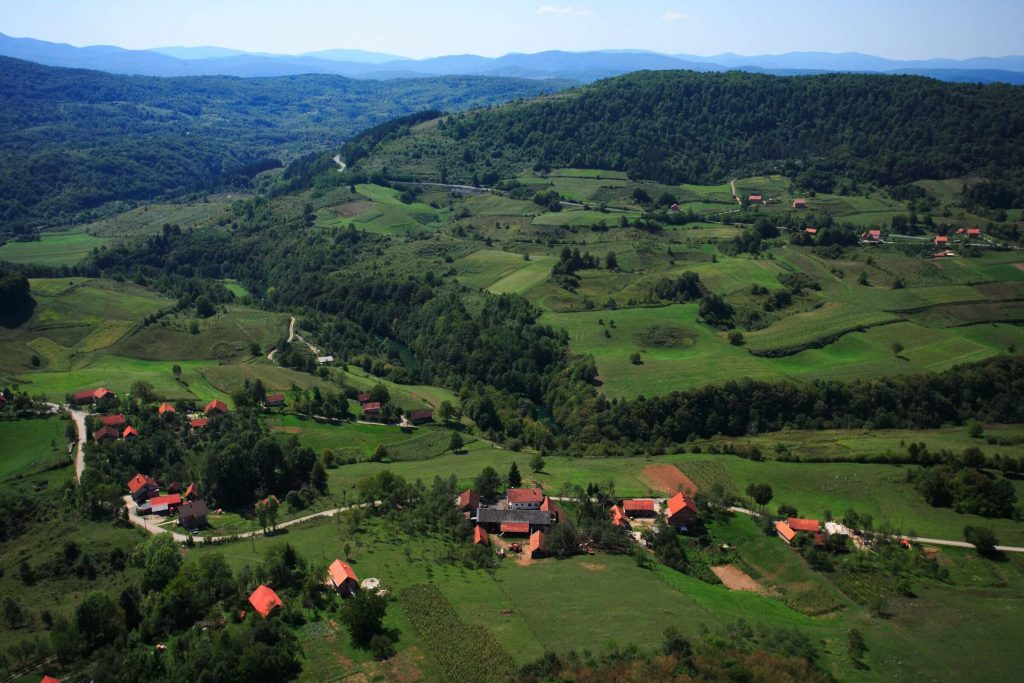Located in central Croatia, the Lika region is bordered by the Adriatic coast to the west, Dalmatia in the south, Bosnia-Herzegovina to the east, and Kordun and Gorski Kotar to the north. It encompasses the inland part of Lika-Senj county and the northernmost part of Zadar county. The regional capital is Gospic, a small town located on the east side of Velebit, the mountain range which separates the inland from the Adriatic coast. The physician Nikola Tesla, the 19th-century politician Ante Starčević, the former Austro-Hungarian Generaloberst Stjepan Sarkotić, and the actor Rade Šerbedžija were all born in Lika.
Lika has traditionally been the least developed part of Croatia. In the 1950s and 1960s, during communism, Croatia was industrialized. However, for some reason, Lika was left behind. Then, the 1991-1995 Homeland War happened. During these years, large parts of Lika were completely devastated. Then, in the 2000s, things began to change. The new Zagreb-Split highway (A1) was built through Lika. Suddenly, Lika became a link between Central Europe and Dalmatia. The highway created new jobs and new opportunities. In 2007, the Nacional newspaper reported that 70% of the companies operating in Lika were doing fine. The Croatian average was 69%. In the wake of the 2008-2009 global financial crisis, many Croats had their bank accounts blocked. In 2019, Lika-Senj county had the lowest percentage of blocked accounts. As we speak, a giant hydroelectric dam is being built in Kosinj. Once completed, it will provide the whole region with electricity and, of course, create new jobs.
In recent years, it seems that Croatia and the world have discovered Lika’s potential. Lika is Croatia’s least developed region, but that comes with an advantage – lower taxes and house prices. Lika has a perfect location, 2 hours from Zagreb and Rijeka and only 1 hour from Zadar. The Adriatic coast can be reached within an hour. It’s fully possible to live in Lika, where the house prices are lower, and work in Zadar, Rijeka, or Zagreb, where the wages are higher. In fact, people are already moving from Slavonia, Dalmatia, and Zagreb to Lika! In the near future, a new highway will be built from Otočac to Rijeka via Senj and Crikvenica, over Velebit and along the Adriatic coastline. Once completed, the travel distance to Rijeka will be reduced to less than 2 hours.
The Lika region is probably most known for the Plitvice Lakes. Located in the northern part of the region, the lakes, with their sparkling turquoise water, are interconnected by a series of waterfalls. In 1979, the area became a national park. The surrounding landscape is like a Bavarian postcard – green forests, rolling hills, and white houses with flower-bedecked balconies. The Karlovac-Zadar route, until 2005 the main traffic link between Zagreb and Dalmatia, runs through the area.
As said, the Velebit mountains separate the inland from the Adriatic coast. Since 1999, the northern part of the Velebit mountains has been a national park. Nature is majestic, with high, forest-clad mountains, deep canyons, and crystal clear streams.
Zavizan, the highest meteorological station in Croatia (1676 m), is located within the national park. The Zavizan peak overlooks the Adriatic Sea and the island of Rab. Not far from the national park lies the Alpine village of Krasno, with its Edelweiss Dairy (Sirana Runolist) and its 18th-century pilgrim’s church. Farther east lies Kuterevo, a small village that is known for its brown bears’ sanctuary. The bears are being taken care of by volunteers from all over the world. All these places are located along the road from Otocac to the coastal town of Senj.
As a matter of fact, the Lika region is full of see-worthy places, from the Gacka field and the crystal clear Gacka river in the north and the historic Krbava field (Krbavsko polje) in the south to the Alpine landscape in the west. The landscape is a mix of the Austrian Alps, the American prairies, the Scandinavian black forests, and the green Bavarian hills. The air and the water are clean, and as said, it’s only 30 minutes to the Adriatic coast. If you want to live in a temperate climate but have the subtropical zone next door, Lika is a perfect choice.
For more, follow our travel section.











